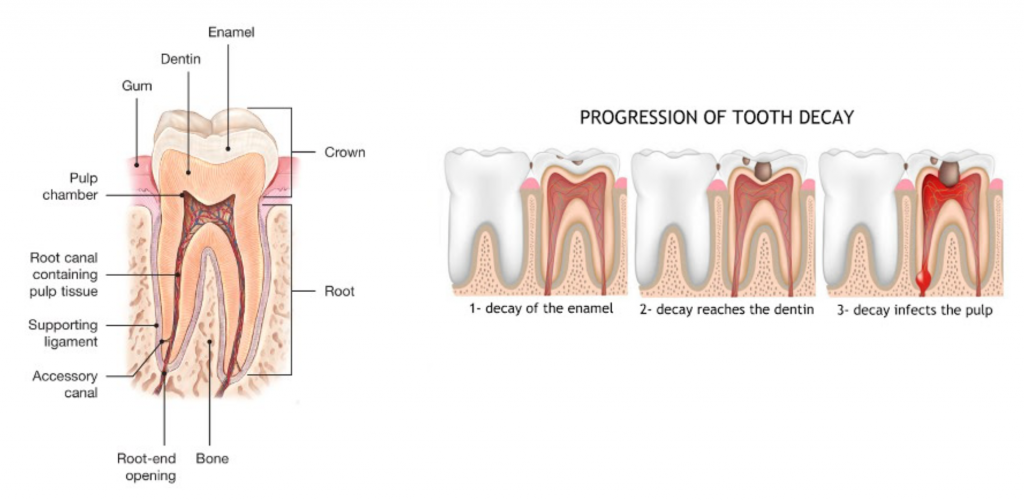Root Canal Therapy
Root canal therapy is recommended when the nerve of the tooth has been damaged. It can be damaged by trauma, a large cavity, or fracture of the tooth.
Inside your tooth, beneath the hard, white outer layer of enamel is softer yellow layer called dentin (which appears orange in the picture below); then after that is the innermost layer of soft tissue called the nerve or pulp (which appears dark red in the picture below). Once decay has reached the pulp, bacteria can travel down the root into the bone and spread to other areas of the body.

How do I know if I need a root canal?
Some common symptoms indicating a possible need for a root canal include:
- Severe tooth pain that wakes you up at night
- Severe tooth pain when eating or when you put pressure on the area
- Sensitivity to hot and cold that lingers for extended periods of time after the hot or cold stimulus is removed
- Swelling or bump in the gums near the area of tooth pain
- Pus or drainage in the mouth
- Darkening of the tooth
Be sure to see your dentist if you experience any of these symptoms. Sometimes your tooth can need a root canal without any of these warning signs. These cases can be revealed during routine check-ups with your dental provider via digital x-ray. Your dentist can track the depth of your cavities via x-rays.
I need a root canal. Now what?
Many patients are scared at the idea of getting a root canal and ask if the tooth can just be pulled. While that would relieve the pain, there is nothing like your natural tooth! A root canal is a great option that allows you to save your tooth.
How do root canals work?
A tooth needs a root canal usually because of a large cavity or crack that has reached the pulp. The cavity or crack is removed with a dental handpiece. Then the infected pulpal tissue as well as the entire nerve of the tooth is removed. Once a permanent tooth erupts fully through the gums, the nerve serves no real purpose other than to sense heat or cold or other stimuli; therefore, removing the nerve is the standard of care in the treating teeth with decay that has reached the pulp. The pulp chamber and root canals of your tooth are then cleaned, medicated, and sealed. A crown is then often recommended to protect and strengthen the tooth. After a root canal treatment and a crown, the tooth often functions just like all of your other teeth!
Does it hurt??
Contrary to popular belief, under the care of our experienced team, root canals are not a painful procedure! In fact, many patients who are in pain prior to the root canal procedure, leave the office in no pain!
A local anesthetic is applied to your tooth and the surrounding area. Then a protective sheet called a rubber dam is placed over your tooth to isolate the tooth to keep it nice and clean throughout to procedure and to protect the airway during the procedure. An opening is made through your tooth to access the pulp chamber and the nerve. The canals are then cleaned and shaped and filled with a biocompatible material known as gutta percha. Then a filling is placed on your tooth followed by a crown.
It is a multi-step procedure that requires multiple appointments, but entirely worth it to save your tooth!
Is something aching? Be sure to ask your knowledgeable team at Energetic Smile to see if root canal therapy can help! Call us today at (714) 594-7009 – don’t have one more painful night!